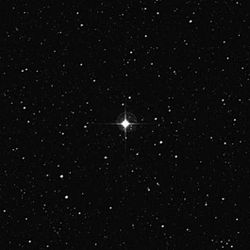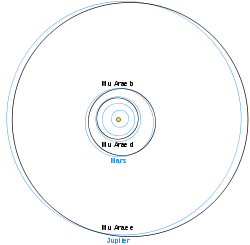
Mu Arae
Did you know...
SOS Children have produced a selection of wikipedia articles for schools since 2005. Before you decide about sponsoring a child, why not learn about different sponsorship charities first?
| Observation data Epoch J2000.0 Equinox J2000.0 |
|
|---|---|
| Constellation | Ara |
| Right ascension | 17h 44m 08.7s |
| Declination | −51° 50' 03" |
| Apparent magnitude (V) | +5.12 |
| Characteristics | |
| Spectral type | G3IV–V |
| U−B colour index | ? |
| B−V colour index | 0.694 |
| Variable type | none |
| Astrometry | |
| Radial velocity (Rv) | −9.0 km/s |
| Proper motion (μ) | RA: −15.06 mas/ yr Dec.: −191.17 mas/ yr |
| Parallax (π) | 65.46 ± 0.80 mas |
| Distance | 49.8 ± 0.6 ly (15.3 ± 0.2 pc) |
| Absolute magnitude (MV) | +4.28 |
| Details | |
| Mass | 1.10 ± 0.05 M☉ |
| Radius | 1.3150 ± 0.0190 R☉ |
| Luminosity | 1.75 ± 0.10 L☉ |
| Temperature | 5813 ± 40 K |
| Metallicity | 210 ± 20% |
| Rotation | 31 days |
| Age | 6410 million years |
| Other designations | |
|
HR 6585, HD 160691, Gl 691, CD-51°11094, FK5 662, HIP 86796, SAO 244981, GC 24024
|
|
Mu Arae (μ Ara / μ Arae) is a Sunlike yellow-orange star located around 50 light years away in the constellation Ara. The star has a planetary system with four known planets, three of them with masses comparable to that of Jupiter. The system's innermost planet was the first "hot Neptune" to be discovered.
Distance and visibility
According to measurements made by the Hipparcos astrometric satellite, Mu Arae exhibits a parallax of 65.46 milliarcseconds as the Earth moves around the Sun. When combined with the known distance from the Earth to the Sun, this means the star is located at a distance of 49.8 light years (15.3 parsecs). Seen from Earth it has an apparent magnitude of +5.12 and is visible to the naked eye.
Stellar characteristics
Mu Arae is estimated to be slightly more massive than our Sun at around 1.10 solar masses. Based on the abundance of iron, it is around twice as enriched in heavy elements as our Sun, and is therefore described as metal-rich. Its surface temperature of around 5800 K is similar to our Sun. The star has a radius estimated to be 31.5% greater than our Sun and is 75% more luminous.
As a star ages, the level of activity in its chromosphere is expected to decline. Based on observed activity levels, the age of Mu Arae is estimated to be around 6,410 million years or 1,450 million years, depending on the theoretical model used. Another way to estimate the star's age is to match its properties with models of stellar evolution. This method suggests an age of around 4,400 million years.
Mu Arae has a listed spectral type of G3IV–V. The G3 part means the star is classified as yellow in colour, similar to our Sun (a G2V star). The star may be entering the subgiant stage of its evolution as it starts to run out of hydrogen in its core. This is reflected in its uncertain luminosity class, between IV (the subgiants) and V ( main sequence dwarf stars like the Sun).
Planetary system
As of August 2006, four extrasolar planets have been detected in orbit around Mu Arae. Three have high masses and are likely to be gas giants. The innermost planet has a mass comparable to that of Uranus and may either be a small gas giant or a large terrestrial planet. The other 3 planets are roughly Jupiter-sized.
Discovery
In 2001, an extrasolar planet was announced by the Anglo-Australian Planet Search team, together with the planet orbiting Epsilon Reticuli. The planet, designated Mu Arae b, was thought to be in a highly eccentric orbit of around 743 days. The discovery was made by analysing variations in the star's radial velocity (measured by observing the Doppler shift of the star's spectral lines) as a result of being pulled around by the planet's gravity.
Further observations revealed the presence of a second object in the system ( Mu Arae c), which was published in 2004. At the time, the parameters of this planet were poorly constrained and it was thought to be in an orbit of around 8.2 years with a high eccentricity.
Later in 2004, a small inner planet designated Mu Arae d was announced with a mass comparable to that of Uranus in a 9-day orbit. This was the first of the class of planets known as "hot Neptunes" to be discovered. The discovery was made by making high-precision radial velocity measurements with the High Accuracy Radial Velocity Planet Searcher (HARPS) spectrograph.
In 2006, two teams, one led by Krzysztof Goździewski and the other by Francesco Pepe independently announced four-planet models for the radial velocity measurements of the star, with a new planet ( Mu Arae e) in a near-circular orbit lasting approximately 311 days. The new model gives revised parameters for the previously known planets, with lower eccentricity orbits than in the previous model. The discovery of the fourth planet made Mu Arae the second known four-planet extrasolar system, after 55 Cancri.
System structure
The Mu Arae system consists of an inner Uranus-mass planet in a tight 9-day orbit and three massive planets, probably gas giants, on wide, near-circular orbits, which contrasts with the high-eccentricity orbits typically observed for long-period extrasolar planets. The Uranus-mass planet may be a chthonian planet, the core of a gas giant which has had its outer layers stripped away by stellar radiation. Alternatively it may have formed in the inner regions of the Mu Arae system as a rocky "super-Earth".
The inner gas giants "e" and "b" are located close to the 2:1 orbital resonance which causes them to undergo strong interactions. The best-fit solution to the system is actually unstable: simulations suggest the system is destroyed after 78 million years, which is significantly shorter than the estimated age of the star system. More stable solutions, including ones in which the two planets are actually in the resonance (similar to the situation in the Gliese 876 system) can be found which give only a slightly worse fit to the data.
Searches for circumstellar discs show no evidence for a debris disc similar to the Kuiper belt around Mu Arae. If Mu Arae does have a Kuiper belt, it is too faint to be detected with current instruments.
| Companion (in order from star) |
Mass | Semimajor axis ( AU) |
Orbital period (days) |
Eccentricity | Radius |
|---|---|---|---|---|---|
| d | >0.03321 MJ | 0.09094 | 9.6386 ± 0.0015 | 0.172 ± 0.04 | — |
| e | >0.5219 MJ | 0.921 | 310.55 ± 0.83 | 0.0666 ± 0.0122 | — |
| b | >1.676 MJ | 1.497 | 643.25 ± 0.90 | 0.128 ± 0.017 | — |
| c | >1.814 MJ | 5.235 | 4205.8 ± 758.9 | 0.0985 ± 0.0627 | — |
Habitability
The gas giant planet "b" is located in the liquid water habitable zone of Mu Arae. This would prevent an Earthlike planet from forming in the habitable zone, however large moons or Trojan planets of the gas giant could potentially support liquid water. On the other hand it is unclear whether such massive moons could actually form around a gas giant planet, thanks to an apparent scaling law between the mass of the planet and its satellite system. In addition, measurements of the star's ultraviolet flux suggest that any potentially habitable planets or moons may not receive enough ultraviolet to trigger the formation of biomolecules.
Planet "e" would receive a similar amount of ultraviolet to the Earth and thus lies in the ultraviolet habitable zone, however, it would be too hot for any moons to support surface liquid water.
Planet naming conventions
The established convention for extrasolar planets is that the planets receive lower-case Roman letters starting from "b", in order of discovery. This system is used by the team led by Goździewski, and has been adopted in this article for compatibility with the designations used previously for the 3-planet model.
On the other hand, the team led by Pepe have proposed a modification of the designation system, where the planets are designated in order of characterisation. Since the parameters of the outermost planet were poorly constrained before the introduction of the 4-planet model of the system, this results in a different order of designations for the planets in the Mu Arae system. Both systems agree on the designation of the 670-day planet as "b". The Pepe system designates the 9-day planet as "c", the 310-day planet as "d" and the outer planet as "e".
Since the International Astronomical Union has not defined an official system for designations of extrasolar planets, the issue of which convention is "correct" remains open.



